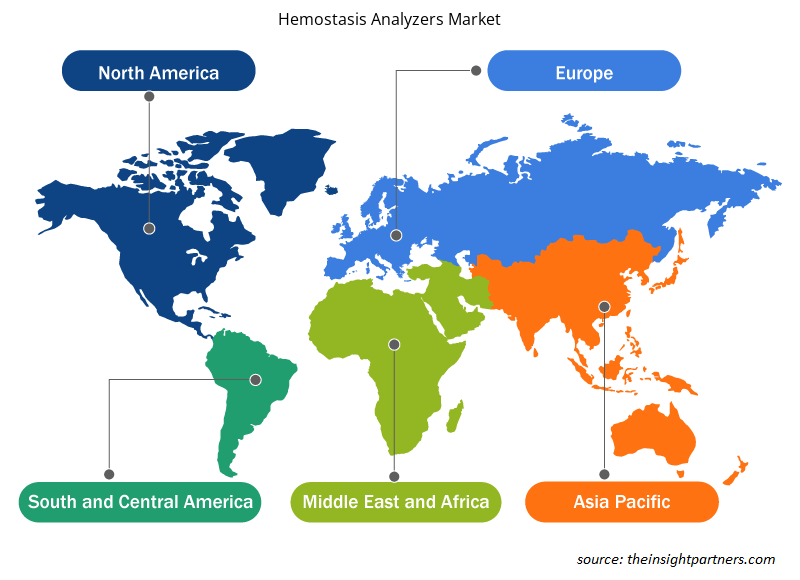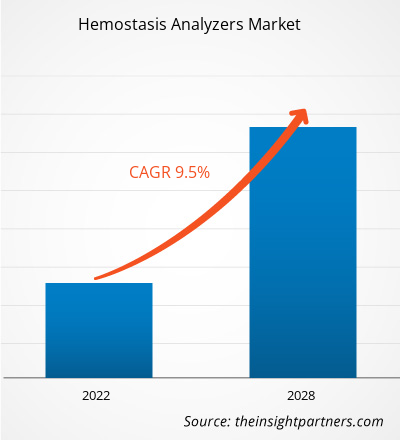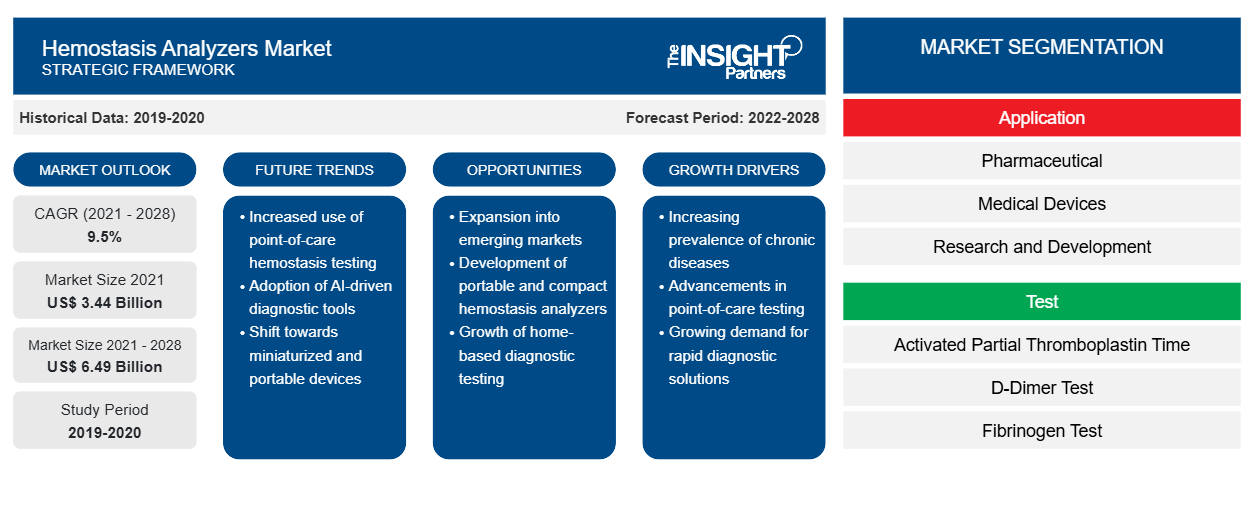Se proyecta que el mercado de analizadores de hemostasia alcance los US$ 6.490,24 millones para 2028 desde los US$ 3.440,66 millones en 2021; se espera que registre una CAGR del 9,5% entre 2021 y 2028.
Los analizadores de hemostasia proporcionan una medición rápida y sencilla de los niveles de plaquetas en sangre. Una prueba de coagulación podría ayudar a detectar y prevenir coágulos de sangre que podrían causar un ataque cardíaco. Un analizador de coagulación puede medir la velocidad de la vía de coagulación y las cantidades de trombolina y tromboplastina en menos de unos minutos. Es probable que las enfermedades cardiovasculares (ECV) sigan siendo la causa más importante de morbilidad y mortalidad en todo el mundo. Las ECV son trastornos del corazón y los vasos sanguíneos e incluyen enfermedad cerebrovascular, enfermedad cardíaca coronaria, enfermedad cardíaca reumática y otras afecciones. Algunos problemas relacionados con el estilo de vida que conducen a enfermedades y dificultades cardiovasculares son el consumo de tabaco, la dieta poco saludable y la inactividad física. Aumentan el riesgo de ataques cardíacos y accidentes cerebrovasculares. Otros factores de riesgo de enfermedades cardiovasculares son la presión arterial alta, la diabetes y el aumento de los niveles de colesterol. Según la Organización Mundial de la Salud (OMS), las enfermedades cardiovasculares son la principal causa de muerte a nivel mundial.
Personalice este informe según sus necesidades
Obtendrá personalización en cualquier informe, sin cargo, incluidas partes de este informe o análisis a nivel de país, paquete de datos de Excel, así como también grandes ofertas y descuentos para empresas emergentes y universidades.
-
Obtenga las principales tendencias clave del mercado de este informe.Esta muestra GRATUITA incluirá análisis de datos, desde tendencias del mercado hasta estimaciones y pronósticos.
Perspectivas de mercado
El aumento de la población geriátrica impulsará el mercado de analizadores de hemostasia
Las personas mayores son propensas a sufrir enfermedades cardíacas debido a un sistema inmunológico débil y otros problemas de salud. Los factores generales de envejecimiento provocan un endurecimiento del corazón y de los vasos sanguíneos, lo que da lugar a trastornos cardíacos. A medida que avanza la edad, la presión arterial sistólica también aumenta, lo que conduce a enfermedades cardiovasculares (ECV). Por tanto, en las personas de 75 años o más, la presión arterial alta es un factor de riesgo común para las enfermedades cardíacas. La enfermedad de las arterias coronarias y la insuficiencia cardíaca son los otros. Aunque la incidencia de arritmias abarca a personas de todos los grupos de edad, está aumentando significativamente entre la población geriátrica.
Según la encuesta Global Ageing 2019, la población mundial de 65 años o más ascendió a 703 millones en 2019. Se espera que el grupo demográfico de la tercera edad se duplique hasta alcanzar los 1.500 millones de personas en 2050. Es probable que la frecuencia de una persona con 65 años o más aumente de 1 de cada 11 habitantes en 2019 a 1 de cada 6 habitantes en 2025. Este grupo demográfico es más susceptible a las enfermedades cardiovasculares, como las arritmias. De manera similar, según la Organización Mundial de la Salud (OMS), se estima que el porcentaje de personas de 60 años o más alcanzará el 22% en 2050, frente al 12% en 2015. Según el informe "Older Americans 2016: Key Indicators of Well-Being" del Foro Interinstitucional Federal sobre Estadísticas Relacionadas con el Envejecimiento, el 35,8% de las personas de 85 años o más tenían un trastorno cognitivo leve o extremo. Además, según el informe de las Naciones Unidas sobre el envejecimiento de la población mundial de 2017, en 2017, 962 millones de personas tenían 60 años o más en todo el mundo, y se espera que la cifra alcance casi los 2100 millones en 2050. La
población de edad avanzada es más propensa a presentar cuadros atípicos, enfermedades comórbidas y resultados desfavorables. La principal causa de las enfermedades está relacionada con los cambios estructurales y funcionales del sistema cardiovascular asociados con el envejecimiento. El aumento de la población geriátrica mundial está provocando un aumento de las enfermedades cardiovasculares, lo que, a su vez, está impulsando la demanda de analizadores de hemostasia.
Información basada en el tipo de producto
Según el tipo de producto, el mercado de analizadores de hemostasia se segmenta en analizadores de laboratorio y sistemas de pruebas en el punto de atención . En 2021, el segmento de analizadores de laboratorio tiene la mayor participación del mercado, y se estima que el segmento de sistemas de pruebas en el punto de atención registrará la CAGR más alta durante 2021-2028.
Cuota de mercado de analizadores de hemostasia por tipo de producto: 2021 y 2028
Perspectivas basadas en pruebas
Según las pruebas, el mercado está segmentado en tiempo de tromboplastina parcial activada, prueba de dímero D, prueba de fibrinógeno, prueba de tiempo de protrombina y otros. En 2021, el segmento de tiempo de tromboplastina parcial activada tuvo la mayor participación del mercado. Se espera que el segmento de prueba de tiempo de protrombina registre la CAGR más alta del mercado durante 2021-2028.
Información basada en el usuario final
Según los usuarios finales, el mercado está segmentado en hospitales/clínicas, laboratorios de diagnóstico independientes, entornos de atención domiciliaria y otros. En 2021, el segmento de hospitales/clínicas representó la mayor participación del mercado. Se espera que el segmento de laboratorios de diagnóstico independientes registre la CAGR más alta del mercado durante 2021-2028.
Las empresas que operan en el mercado de analizadores de hemostasia enfatizan la adopción de la estrategia de innovaciones de productos para satisfacer las cambiantes demandas de los clientes en todo el mundo, lo que también les permite mantener su marca en el mercado global.
Segmentación del mercado de analizadores de hemostasia
El mercado de analizadores de hemostasia está segmentado en función del tipo de producto, la prueba y el usuario final. Según el tipo de producto, el mercado de analizadores de hemostasia se segmenta en analizadores de laboratorio y sistemas de prueba en el punto de atención. Según la prueba, el mercado se segmenta aún más en tiempo de tromboplastina parcial activada, prueba de dímero D, prueba de fibrinógeno, prueba de tiempo de protrombina y otros. Según el usuario final, el mercado se segmenta en hospitales/clínicas, laboratorios de diagnóstico independientes, entornos de atención domiciliaria y otros. En términos geográficos, el mercado de analizadores de hemostasia está segmentado en América del Norte (EE. UU., Canadá y México), Europa (Francia, Alemania, Italia, Reino Unido, España y el resto de Europa), Asia Pacífico (Australia, China, India, Japón, Corea del Sur y el resto de APAC), Oriente Medio y África (Arabia Saudita, Sudáfrica, Emiratos Árabes Unidos y el resto de MEA) y América del Sur y Central (Brasil, Argentina y el resto de SCAM)
Perspectivas regionales del mercado de analizadores de hemostasia
Los analistas de Insight Partners explicaron en detalle las tendencias y los factores regionales que influyen en el mercado de analizadores de hemostasia durante el período de pronóstico. Esta sección también analiza los segmentos y la geografía del mercado de analizadores de hemostasia en América del Norte, Europa, Asia Pacífico, Oriente Medio y África, y América del Sur y Central.

- Obtenga datos regionales específicos para el mercado de analizadores de hemostasia
Alcance del informe de mercado de analizadores de hemostasia
| Atributo del informe | Detalles |
|---|---|
| Tamaño del mercado en 2021 | US$ 3,44 mil millones |
| Tamaño del mercado en 2028 | 6.490 millones de dólares estadounidenses |
| CAGR global (2021-2028) | 9,5% |
| Datos históricos | 2019-2020 |
| Período de pronóstico | 2022-2028 |
| Segmentos cubiertos |
Por aplicación
|
| Regiones y países cubiertos |
América del norte
|
| Líderes del mercado y perfiles de empresas clave |
|
Densidad de actores del mercado: comprensión de su impacto en la dinámica empresarial
El mercado de analizadores de hemostasia está creciendo rápidamente, impulsado por la creciente demanda de los usuarios finales debido a factores como la evolución de las preferencias de los consumidores, los avances tecnológicos y una mayor conciencia de los beneficios del producto. A medida que aumenta la demanda, las empresas amplían sus ofertas, innovan para satisfacer las necesidades de los consumidores y aprovechan las tendencias emergentes, lo que impulsa aún más el crecimiento del mercado.
La densidad de actores del mercado se refiere a la distribución de las empresas o firmas que operan dentro de un mercado o industria en particular. Indica cuántos competidores (actores del mercado) están presentes en un espacio de mercado determinado en relación con su tamaño o valor total de mercado.
Las principales empresas que operan en el mercado de analizadores de hemostasia son:
- Siemens AG
- Laboratorio de Instrumentación
- Abad
- Corporación Sysmex
- Corporación Nihon Kohden
Descargo de responsabilidad : Las empresas enumeradas anteriormente no están clasificadas en ningún orden particular.

- Obtenga una descripción general de los principales actores clave del mercado de analizadores de hemostasia
Perfiles de empresas
- Siemens AG
- Laboratorio de Instrumentación
- Abad
- Corporación Sysmex
- Corporación Nihon Kohden
- Termo Fisher Scientific Inc.
- Diagnóstico Roche
- Diagnóstico de Stago
- Laboratorios Helena
- Corporación Internacional Technidyne.
- Análisis histórico (2 años), año base, pronóstico (7 años) con CAGR
- Análisis PEST y FODA
- Tamaño del mercado, valor/volumen: global, regional y nacional
- Industria y panorama competitivo
- Conjunto de datos de Excel
Informes recientes
Testimonios
Razón para comprar
- Toma de decisiones informada
- Comprensión de la dinámica del mercado
- Análisis competitivo
- Información sobre clientes
- Pronósticos del mercado
- Mitigación de riesgos
- Planificación estratégica
- Justificación de la inversión
- Identificación de mercados emergentes
- Mejora de las estrategias de marketing
- Impulso de la eficiencia operativa
- Alineación con las tendencias regulatorias























 Obtenga una muestra gratuita para - Mercado de analizadores de hemostasia
Obtenga una muestra gratuita para - Mercado de analizadores de hemostasia